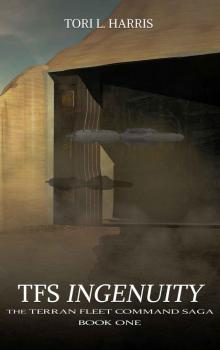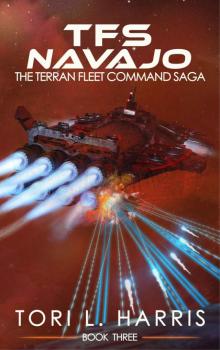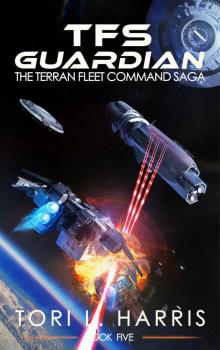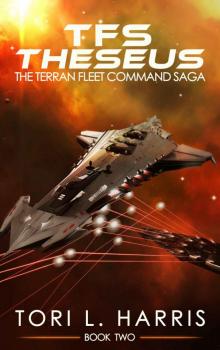- Home
- Tori Harris
The Terran Fleet Command Saga BoxSet
The Terran Fleet Command Saga BoxSet Read online
The Terran Fleet Command Saga
Books 1-3
TFS INGENUITY
TFS THESEUS
TFS NAVAJO
*****
Tori L. Harris
Table of Contents
TFS Ingenuity
Prologue
Chapter 1
Chapter 2
Chapter 3
Chapter 4
Chapter 5
Chapter 6
Chapter 7
Chapter 8
Chapter 9
Chapter 10
Chapter 11
Chapter 12
Chapter 13
Chapter 14
Chapter 15
TFS Theseus
Chapter 1
Chapter 2
Chapter 3
Chapter 4
Chapter 5
Chapter 6
Chapter 7
Chapter 8
Chapter 9
Chapter 10
Chapter 11
Chapter 12
Chapter 13
Chapter 14
Chapter 15
Chapter 16
Chapter 17
Chapter 18
Chapter 19
Chapter 20
TFS Navajo
Chapter 1
Chapter 2
Chapter 3
Chapter 4
Chapter 5
Chapter 6
Chapter 7
Chapter 8
Chapter 9
Chapter 10
Chapter 11
Chapter 12
Chapter 13
Chapter 14
Chapter 15
Chapter 16
Chapter 17
Chapter 18
Chapter 19
Chapter 20
Chapter 21
Epilogue
TFS INGENUITY
The Terran Fleet Command Saga – Book 1
*****
Tori L. Harris
No captain can do very wrong if he places his ship alongside that of the enemy.
Vice Admiral Horatio Nelson
TFS Ingenuity
Prologue
Sol System, Near the Jovian Orbital Path
(0609 UTC - 9.5x108 km from Earth)
The probe’s brief appearance in normal space was intentionally discreet. The small ship, if it could even be called a ship at less than a meter in length, was designed to be all but undetectable to the technology available to any species it was expected to encounter during its mission. That certainly included the rather primitive species represented by the approaching squadron of nine warships and four support vessels.
Had any of the approaching ships been scanning the area roughly one hundred fifty thousand kilometers to port with their most powerful optical sensors, they might have detected a small flash of light, followed a few seconds later by another. Otherwise, they were provided no warning whatsoever of the devastating attack that was now imminent.
The probe’s quick reconnaissance of the enemy squadron provided a wealth of data with which to plan an attack. Since the scan was completely passive in nature, there were no detectable sensor emissions. With optics, of course, there was no getting around Einsteinian physics. The probe’s sensor suite received only a few seconds worth of "new light" during its encounter with the enemy ships, but this had been more than enough. The high resolution scan still covered a spherical volume of space with a diameter of over one million kilometers. Any targeting data beyond that distance was deemed less reliable, but could still be used in case things didn’t go exactly as planned during the coming engagement.
Now at a safe distance and camouflaged by a particularly dense group of asteroids orbiting between the fourth and fifth planets in the Sol system, the probe rejoined its mothership. Even before the docking process was complete, all of its valuable reconnaissance data had been uploaded, causing the fifty-meter-long mothership to pause momentarily and consider its options.
The approaching enemy squadron was composed of well-known ship types with well-known capabilities – with one notable exception. Based on its emissions and power levels, that particular ship did appear to be significantly more advanced than the others, but it was of little consequence. The mothership calculated that it still enjoyed an overwhelming advantage in every category from power generation, to shielding, to speed and maneuverability, to weapons. The outcome of a confrontation with this enemy was all but certain. No, the real question was the best course of action in support of its mission directives, which was orders of magnitude more complex than destroying the inferior enemy squadron.
Over five hundred years earlier, the mothership had been given three directives that would govern its mission for centuries to come. In descending order of priority, they were:
Neutralize any direct threat to the Pelaran alliance.
Cultivate the species inhabiting the third planet of the Sol system (Terra) as a Pelaran regional proxy.
Prevent damage to Pelaran property and economic interests, except when in conflict with the first two directives. This includes self-preservation of all Guardian Cultivation Systems (GCS).
The Makers were many things, but micromanagers they were not. The Guardians they created had been given wide discretion to interpret both the intent of their mission directives as well as their practical application. Each mission could, after all, last a thousand years or more (based on the orbital period of Terra).
In the case of the approaching enemy ships, directives one and three were not a factor. These primitives clearly represented no direct threat to any member of the Pelaran Alliance … at least not yet. Based on the design of their ships, their technology was at least a millennium behind even the most backwater Alliance affiliate. Directive three actually did evaluate to a nonzero probability, largely due to the unknown capabilities of the previously unknown ship in the enemy formation. Realistically, however, the threat to the Guardian was deemed inconsequential.
No, as usual, the problem was directive two, how best to cultivate an adolescent race, in this case the Terrans, in such a way that they became the dominant regional power while also creating a sense of loyalty, indebtedness, and dependency upon the Pelaran Alliance. At the moment, directive two simply implied that the approaching ships could not be allowed to approach Terra, but where the Humans were concerned, nothing was ever as simple as it seemed. While they did share the common genetic heritage with the Makers as required of all cultivated species, the Terrans were proving to be a race of petulant, arrogant children that was nearly impossible to control.
Cultivation of proxy species had been considered a morally superior method of maintaining regional stability for thousands of years. The system had been codified in various treaties between ancient, immensely powerful civilizations and alliances, and was designed to prevent their ever coming into direct open conflict (the results of which would be unthinkable). It allowed less populated areas to develop along a reasonably natural technological and cultural timeline without the need for excessive intervention. Still, it was sometimes difficult for the GCS to understand why a simple purge of any species deemed a threat to regional stability was not also considered a morally viable option.
As the Humans illustrated on a daily basis, practical application of cultivation theory was an incredibly delicate and complicated undertaking. The general idea was to choose a species with genetic ties to an Alliance member (preferably a civilization developing along a similar cultural path). The selected species was then guided through the most unstable and dangerous portion of their maturing process. This was accomplished primarily through the rapid introduction of key technologies at a rate betwee
n ten and fifty times their projected developmental timeline.
Unfortunately, cultivation theory rarely followed a cookbook approach. Deployment of a Guardian Cultivation System depended on a myriad of factors including the mean intelligence of the species under cultivation, regional galactic population density, and literally thousands of other factors. It was also critical to ensure that the cultivated species did not experience an accidental first contact with another species or a premature discovery of non-native technological artifacts.
On average, a species received guardianship approximately three to five hundred years before its first, tentative steps into interstellar space. How long the GCS "loitered" in the region depended in large part on how quickly the cultivated species reached the required level of self-sufficiency and regional supremacy. In the case of the Humans, it had sometimes been difficult to imagine that they would ever fully realize this goal, but they had come a very long way in a relatively short period of time, hadn’t they?
With its brief contemplation on the finer points of cultivation theory completed, the time for action in support of directive two had arrived. The question now was what action to take? The most conservative approach was to immediately intercept and destroy the approaching enemy squadron. There was absolutely no doubt that they were enemies of the Humans, or eventually would be (even though the Humans had only the vaguest notion that they even existed). They were the Wek, the most aggressive member species of an expansionist coalition known as the Sajeth Collective. Controlling species like the Wek and their potentially bothersome regional alliances was one of the primary objectives of the cultivation program.
Another option was to even the odds a bit and then allow the Humans to deal with the remaining threat themselves. In cases like this where the species under cultivation were still relatively weak militarily, this approach, while potentially messy, sometimes yielded dramatic results. Typically, the resulting loss of life and property spurred even the most passive of civilizations to the realization that their neighborhood of the galaxy was not nearly as safe as they had once imagined.
The final option was to do nothing and see how the Humans fared on their own. In this scenario, however, even this small squadron of enemy ships had more than enough firepower to render the Humans defenseless in a matter of minutes, and potentially extinct a few hours later. This scenario might require the GCS to intervene in close proximity to the planet, which would most likely render it visible, openly announcing its presence to the Humans. Although the Guardian sensed that the time for direct contact was rapidly approaching, it calculated that the optimum time had not yet arrived to do so.
So many things to consider, and so much potential for complete mission failure. Not for the first time in the past five centuries on station near Terra, the Guardian experienced an uncomfortable mix of what the Humans might call anxiety and boredom. Consciousness, it turns out, was overrated. This was certainly true when it included self-awareness of one’s own personal responsibilities. The GCS indulged itself for several hundred femtoseconds by observing that when you happen to be a sentient spacecraft possessed of world-shaping intelligence and brimming with a godlike array of weapons, an overdeveloped sense of irony wasn’t particularly helpful either.
Mere seconds after the Wek squadron emerged from months of hyperspace travel, the Guardian had completed a detailed reconnaissance, assessed the situation, and determined that they must be destroyed immediately in accordance with directive two.
In the extremely unlikely event that the Guardian itself was destroyed in combat, a communications drone detached and positioned itself inside a crater on a nearby asteroid. The drone would remain hidden in this location during the coming battle. If the GCS was lost, it was capable of returning to Pelara on its own with a complete mission log in its memory core. With its limited power generation capabilities, however, the trip would take several Terran years. Under those circumstances, it was unlikely that a follow-up mission would be undertaken in the near term. The hapless Terran civilization would be categorized as presumed destroyed, pending confirmation at a later date.
Fortunately for the unsuspecting Terrans, The Makers had been designing starships for a thousand years before any species in the Sajeth Collective had discovered the basic principles of atmospheric flight. They had designed the Guardian Cultivation System for a broad spectrum of missions, but it was particularly well-suited for this type of engagement.
When it came right down to it, the key to successful long-range space travel and space warfare was actually quite simple. The ship capable of generating the most power tended to travel farther and faster, and then dominate its enemies after arriving at its destination. With technology perfected and handed down across hundreds of generations of Makers, the GCS was capable of producing a vast supply of power. So vast, in fact, that compared with the ships in the approaching squadron, its power output was practically without limitation.
Although this was the first tactical encounter the Guardian had experienced in over fifty years, its combat-related systems treated the situation as merely routine – nothing more than a precisely calculated response to the current threat. With Terra less than one light hour from the approaching squadron, the time for action had come.
With another faint blue flash, the Guardian spacecraft engaged its hyperdrive and transitioned to a position well above, but as near as possible to the center of the Wek formation. So much of space combat strategy was dictated by the speed of light (in so-called "normal space" at least). It was the one rule that all participants were forced to, if not obey, then at least acknowledge as having a significant influence on tactics. To achieve initial surprise, the Guardian calculated that it had approximately one hundred milliseconds for Sol’s light reflecting off its hull to cover the distance to the closest Wek ship. The first salvo from its array of pulsed antihydrogen beam weapons arrived a mere thirty milliseconds later.
The GCS was a small vessel with only sixteen beam emitters, but this was sufficient to assign every target in the Wek formation at least one impact. Each of the support vessels and smaller warships were targeted by only one emitter, leaving two for each of the largest three vessels, including the one with unknown capabilities. The beam weapons were designed to fire packetized pulses in rapid succession, which allowed each pulse to (very briefly) interact with the hull of the target before the next pulse arrived. Aiming points were predetermined based on the reconnaissance probe’s positional data as well as each vessel’s energy signature. The known, or most probable, location of an enemy ship’s power systems was usually the target of choice for the opening salvo.
The Wek support ships were positioned slightly behind the warships. So it was that a five-hundred-meter-long supply vessel was the first to receive the Guardian’s fire. Although the beam’s coherence was reduced slightly as it interacted with the vessel’s shields, the majority of the packetized antihydrogen particles reached the target’s hull, striking at a velocity only slightly less than the speed of light. Atomic level annihilation occurred instantaneously at the point of impact, tearing into the ship’s armor plating and releasing vast quantities of energy. As subsequent packets of energy arrived at the same location, the heavier alloys in the ship’s hull were disrupted to a state exceeding their atomic binding energy. Runaway fission reactions occurred as the antimatter came into contact with the hull’s more vulnerable inner layers. At this point, a jagged line beginning at the original point of impact and exiting on the opposite side of the ship erupted with a continuous series of nuclear detonations. The ship was instantly ripped in half, each section trailing multiple streams of gas and debris, including the bodies of her Wek crew, as they spun off into space.
Much the same occurred with the other ships in the enemy formation. The warships, with more powerful shields and heavier armor, withstood the Guardian’s fire slightly longer than the support ships, albeit only milliseconds longer. From the point of view of the Wek squadron, they had reached the
Terran system after months of hyperspace travel only to be destroyed within mere seconds of their arrival.
With the immediate threat neutralized, the Guardian ship ceased fire. A quick battle damage assessment confirmed the destruction of the entire Wek squadron with one exception – the warship of unknown capabilities. The ship had simply no longer been present in the enemy formation when the attack began. This was always a risk when conducting a Before Light Arrival, or BLA attack. Opening fire on an enemy before there was any possibility of their detecting your presence provided a tremendous tactical advantage, but there was always a chance that the disposition of the enemy’s forces could have changed during the brief period between reconnaissance and battle. Generally, this was only a concern when fighting a much more advanced enemy. The fact that it had happened in this particular battle was troubling to the GCS.
The new enemy ship type, now designated SC Fader 1, had clearly reentered hyperspace within seconds of its initial arrival in system. Executing multiple hyperspace transitions within a short period of time was a surprisingly difficult technical challenge, even for civilizations that had possessed FTL technology for centuries. In fact, this was not a capability previously encountered in any of the spacefaring species within five hundred light years of the Sol system. The Wek, or one of their allies, had either achieved a lucky technological breakthrough, or, worse, unauthorized technological sharing was taking place within this region.
The Wek ship could be tracked, of course, but doing so would take time and require the use of other Pelaran resources. The most immediately pressing question was why the ship had chosen to depart the area immediately after its arrival. The possibilities included everything from a preplanned tactic designed to foil an expected BLA attack to the enemy actually detecting the Guardian’s reconnaissance probe. None of the most likely explanations were good news for directive two.
As the implications of the Wek incursion unfolded in the Guardian’s consciousness, one outcome now seemed all but inevitable: The time for direct first contact with the Humans was near at hand.

 The Terran Fleet Command Saga BoxSet
The Terran Fleet Command Saga BoxSet TFS Ingenuity: The Terran Fleet Command Saga – Book 1
TFS Ingenuity: The Terran Fleet Command Saga – Book 1 TFS Navajo: The Terran Fleet Command Saga – Book 3
TFS Navajo: The Terran Fleet Command Saga – Book 3 TFS Guardian: The Terran Fleet Command Saga – Book 5
TFS Guardian: The Terran Fleet Command Saga – Book 5 TFS Theseus: The Terran Fleet Command Saga – Book 2
TFS Theseus: The Terran Fleet Command Saga – Book 2